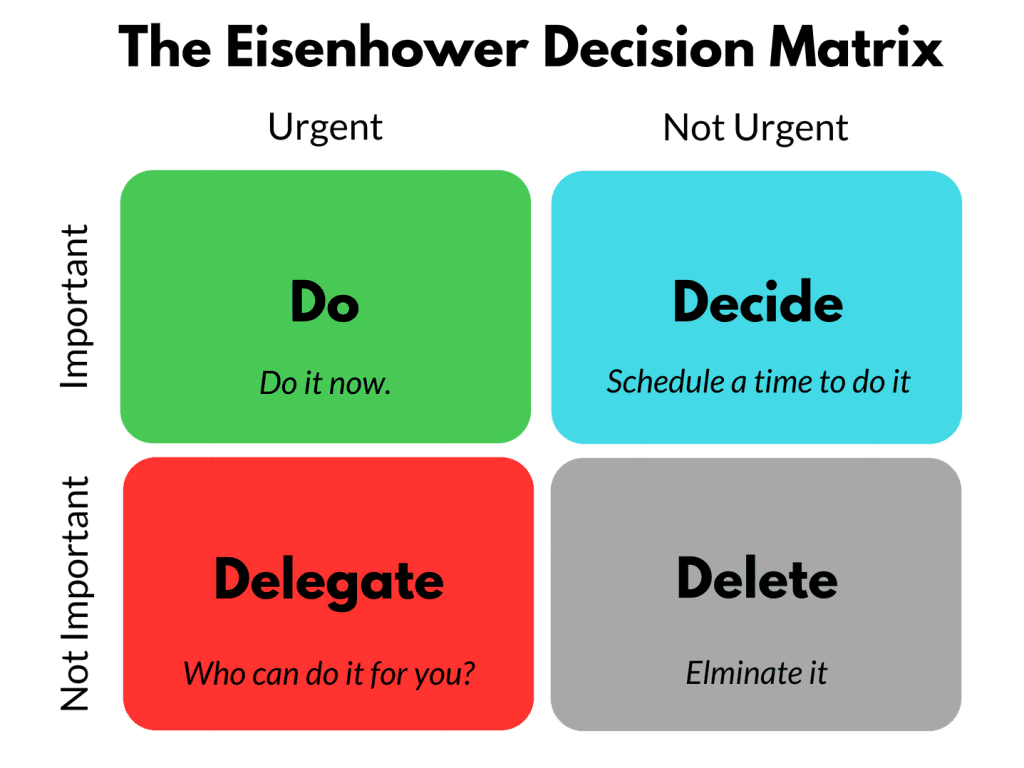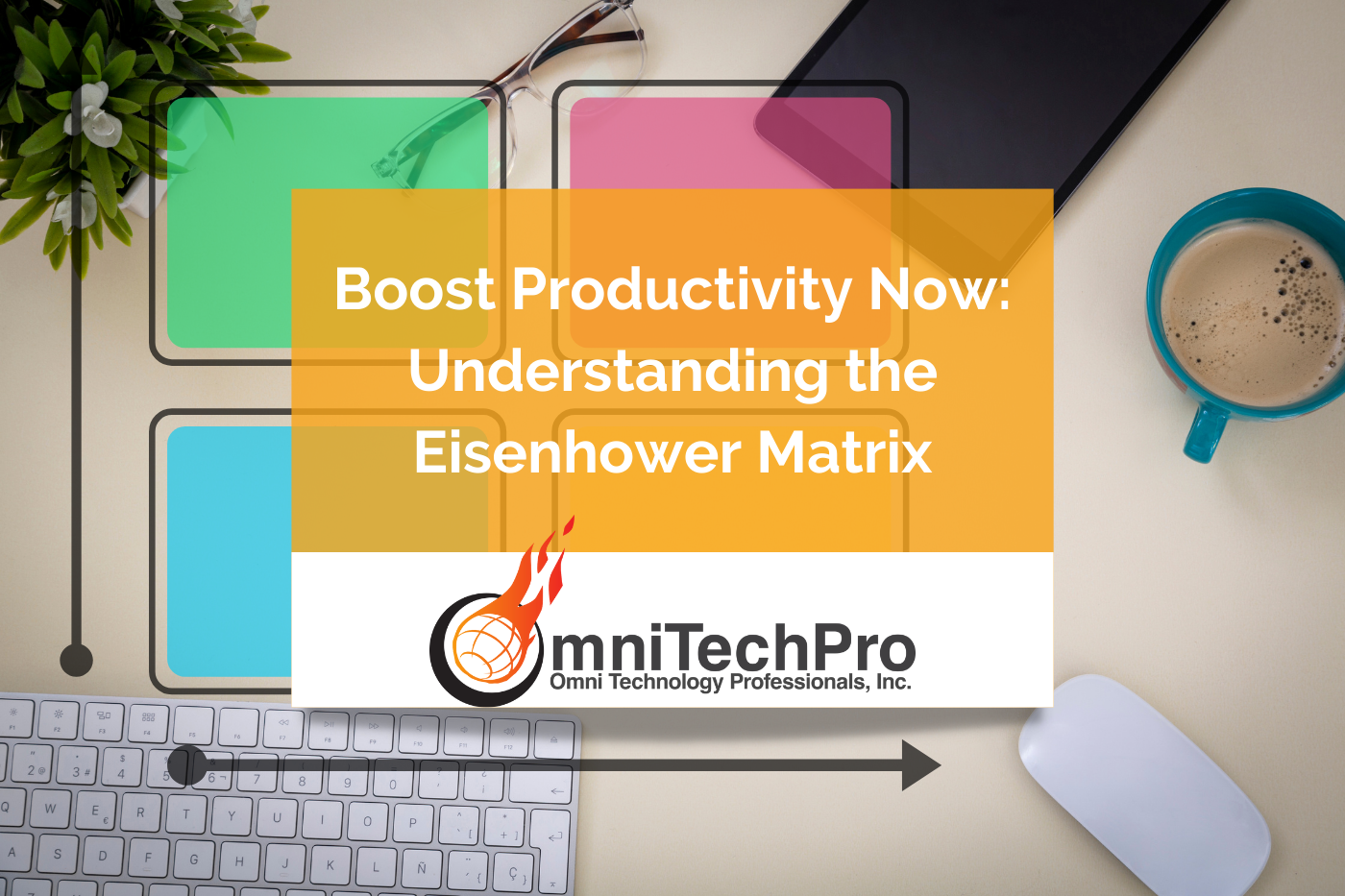Chapter 1. Introduction to the Eisenhower Matrix
1.1. The Genesis of the Eisenhower Matrix
The Eisenhower Matrix, a timeless framework for task management, owes its inception to Dwight D. Eisenhower, the 34th President of the United States. Known for his exceptional leadership skills as a military general and President, Eisenhower developed a simple yet profound method to prioritize tasks based on their urgency and importance. This method, now known as the Eisenhower Matrix, is a cornerstone for effective time management and productivity strategies.
Eisenhower’s guiding principle was straightforward: “What is important is seldom urgent, and what is urgent is seldom important.” This maxim laid the foundation for the matrix, distinguishing tasks across four quadrants—urgent and important, important but not urgent, urgent but not important, and neither urgent nor important. Individuals can focus on what truly matters by categorizing tasks into these quadrants delegating or eliminating the rest.
1.2. Why the Eisenhower Matrix Matters Today
In today’s fast-paced world, where the line between urgency and importance often blurs, the Eisenhower Matrix remains a relevant and powerful tool for managing an overwhelming to-do list. Its simplicity belies its effectiveness in helping individuals and teams discern between tasks requiring immediate attention and those contributing to long-term goals.
The Eisenhower Matrix is not just about sorting tasks; it’s a philosophy of productivity that encourages a proactive rather than reactive approach to work and life. It aligns perfectly with modern productivity methodologies, offering a clear framework for making daily decisions that enhance efficiency and reduce stress. By applying the Eisenhower Matrix, professionals can navigate the complexities of modern work environments with greater ease, ensuring that their efforts align with their highest priorities.
In an era of constant digital distractions and the demand for our time is incessant, the Eisenhower Matrix provides clarity. It empowers individuals to take control of their schedules, focus on what truly advances their goals, and, ultimately, achieve a greater sense of balance and accomplishment.
The relevance of the Eisenhower Matrix today is undeniable. It is a testament to Eisenhower’s insight into the human condition and our perennial struggle to balance the urgent with the important. By incorporating this matrix into our daily lives, we honor his legacy while paving the way for a more productive, purposeful future.
Chapter 2. The Anatomy of the Eisenhower Matrix
The Eisenhower Matrix stands as a beacon of clarity in the complex world of task management, offering a structured approach to navigating the maze of daily responsibilities. Its elegantly simple framework divides tasks into four distinct quadrants, each representing a unique combination of urgency and importance. Understanding the anatomy of the Eisenhower Matrix is pivotal for anyone looking to enhance their productivity and prioritize with precision.

2.1. Quadrant I: Do (Important and Urgent)
The first quadrant is where immediate action resides. Tasks that are both important and urgent demand your attention without delay. These are the critical missions of your day-to-day battle against time, including deadlines that loom large and crises that erupt without warning. The mantra here is clear: act swiftly and decisively. Prioritizing these tasks ensures you address pivotal issues before they escalate, maintaining your momentum and safeguarding your goals.
- Examples: Completing a project with an imminent deadline, responding to a critical work email, or addressing a family emergency.
- Strategies: Implement time-management techniques such as time blocking to allocate specific hours for these tasks, ensuring they receive the immediate attention they require.
2.2. Quadrant II: Schedule (Important but Not Urgent)
Quadrant II is the strategic heart of the Eisenhower Matrix, where the seeds of long-term success are sown. These tasks are crucial for achieving your overarching objectives but lack the pressing deadline of Quadrant I activities. This is the domain of planning, development, and deep work—activities that, while not demanding immediate action, are essential for sustained growth and achievement.
- Examples: Strategic planning, personal development, and relationship building.
- Tips: Schedule regular time slots for these tasks to ensure they progress without being overshadowed by more urgent, yet possibly less important, tasks.
2.3. Quadrant III: Delegate (Urgent but Not Important)
The third quadrant challenges the instinct to react to urgency, urging instead a delegation of tasks that, while pressing, do not contribute directly to your key goals. These are the distractions that can derail a day if not managed wisely. Learning to delegate these tasks frees up valuable time for Quadrants I and II, ensuring that urgency does not override importance in your decision-making process.
- Examples: certain emails or phone calls, meetings, and administrative tasks.
- Tools and Techniques: Leverage communication and project management tools to delegate and track the progress of these tasks efficiently.
2.4. Quadrant IV: Delete (Not Urgent and Not Important)
Finally, Quadrant IV holds tasks that neither advance your goals nor press for immediate action. This quadrant is about identifying and eliminating the noise cluttering your to-do list and mind. By cutting out these tasks, you reclaim time and energy for the activities that truly matter, enhancing your productivity and well-being.
- Examples: Mindless web browsing, excessive television watching, or engaging in gossip.
- The Psychological Benefits: Regularly pruning your responsibilities this way can decrease stress, increase focus, and a more fulfilling engagement with the tasks that genuinely contribute to your success.
Understanding the Eisenhower Matrix is the first step toward mastering your tasks and time. By categorizing your tasks according to these quadrants, you can navigate your day more confidently and efficiently, focusing on what truly matters and steering clear of what does not. This strategic approach enhances productivity and contributes to a more balanced and purposeful life.
Chapter 3. Implementing the Eisenhower Matrix in Daily Life
The Eisenhower Matrix isn’t just a theoretical concept; it’s a practical tool that, when applied correctly, can transform your approach to personal and professional productivity. Understanding how to integrate this matrix into your daily life is crucial for anyone looking to optimize their time and prioritize their tasks more effectively. This chapter delves into the practical application of the Eisenhower Matrix, providing insights and strategies to tailor it to your personal and professional needs.
3.1. Personal Productivity and the Eisenhower Matrix
Tailoring the Matrix to Personal Task Management
The beauty of the Eisenhower Matrix lies in its adaptability to various aspects of life, including personal task management. By categorizing tasks into the four quadrants, individuals can gain clarity on what truly matters, helping to align daily actions with broader life goals.
- Creating a Daily Matrix: Begin each day by listing tasks and assigning them to the appropriate quadrant. This exercise not only helps in prioritizing tasks but also in identifying activities that may not contribute to your overall objectives.
- Balancing Long-term Goals: Use the matrix to balance urgent daily tasks with steps toward long-term aspirations. This ensures that immediate pressures do not overshadow plans.
Case Studies: Successful Personal Implementations
Real-life examples serve as powerful testimonials to the efficacy of the Eisenhower Matrix in personal productivity. From individuals who have successfully balanced career ambitions with personal development to those who have harnessed the matrix to achieve remarkable personal goals, these stories inspire and illustrate the practical application of the matrix in diverse scenarios.
3.2. The Eisenhower Matrix in Professional Settings
Adapting the Matrix for Team and Organizational Productivity
The Eisenhower Matrix can be a game-changer in professional environments, streamlining workflows and enhancing team efficiency. Here’s how organizations can leverage the matrix:
- Team Meetings: Use the matrix as a framework for team meetings to categorize tasks and allocate resources effectively. This ensures that urgent tasks are promptly addressed while important strategic goals are pursued consistently.
- Project Management: Integrating the Eisenhower Matrix into project management tools can help teams prioritize project tasks, making meeting deadlines and achieving project objectives easier.
Tools and Software That Support the Eisenhower Methodology
In today’s digital age, numerous tools and software can help implement the Eisenhower Matrix more effectively. From task management apps that allow for quadrant categorization to collaborative platforms that enable teams to visualize and prioritize tasks collectively, technology plays a crucial role in bringing the Eisenhower Matrix to life in professional settings.
Implementing the Eisenhower Matrix in daily life, whether for personal productivity or within professional settings, requires consistent practice and a willingness to adapt. By understanding how to tailor the matrix to your specific needs and leveraging the right tools, you can maximize your productivity and navigate the complexities of daily tasks with confidence and clarity. This practical approach enhances immediate task management and contributes to achieving long-term goals and aspirations.
Chapter 4. Common Challenges and Solutions
Implementing the Eisenhower Matrix into your daily routine can revolutionize how you manage tasks and allocate your time. However, adapting it to fit your unique lifestyle and work demands can present challenges like any system. Recognizing and overcoming these hurdles is key to harnessing the full power of this productivity tool.
4.1. Overcoming Overwhelm with the Eisenhower Matrix
Identifying the Root Causes of Overwhelm
The first step in overcoming overwhelm is identifying its sources. For many, the sheer volume of tasks can feel unmanageable, while for others, the challenge lies in distinguishing between what’s urgent and what’s truly important. The Eisenhower Matrix demands a clear differentiation between these categories, a skill that requires practice and reflection.
- Strategies to Prevent Task Overload:
- Regular Reviews: Conduct daily and weekly reviews of your tasks to ensure they are correctly categorized within the matrix. This habit not only helps in prioritizing tasks but also in identifying potential overload before it becomes unmanageable.
- Limiting Task Inflow: Be proactive in determining the number of new tasks you take. Use the matrix to assess the importance and urgency of new tasks before adding them to your list.
How to Refine Task Categorization Skills
Mastering the Eisenhower Matrix involves developing the ability to categorize tasks quickly and accurately. This skill is crucial in preventing overwhelm and ensuring the system serves its purpose of simplifying your workload.
- Practical Exercises:
- Categorization Practice: Regularly practice categorizing hypothetical tasks to hone your decision-making skills.
- Seek Feedback: Discuss your categorization choices with a mentor or colleague to gain insights and perspectives.
4.2. Maximizing the Impact of the Eisenhower Matrix
Advanced Tips for Prioritizing and Decision-Making
You must go beyond basic task sorting to benefit from the Eisenhower Matrix truly. Advanced prioritization involves looking at tasks in the context of overall goals and long-term plans.
- Align Tasks with Goals: Ensure that Quadrants I and II tasks align with your broader objectives. This alignment guarantees that your efforts contribute to your long-term success.
- Decision-Making Frameworks: Incorporate decision-making frameworks, such as cost-benefit analysis, to evaluate the importance of tasks more effectively.
Avoiding Common Pitfalls and Mistakes
Even with a clear understanding of the Eisenhower Matrix, it’s easy to fall into certain traps. Awareness of these common mistakes can help you navigate around them.
- Over-prioritizing Urgent Over Important: Resist the urge to focus solely on urgent tasks at the expense of important ones. This short-term focus can lead to long-term setbacks.
- Neglecting Personal Time: Remember to categorize personal time and self-care as important tasks. These are crucial for maintaining your overall productivity and well-being.
Implementing the Eisenhower Matrix is a dynamic process that involves continuous learning and adjustment. By addressing common challenges and refining your approach to task management, you can maximize the impact of this powerful tool. This process enhances productivity and contributes to a more balanced and fulfilling life.
Chapter 5. Beyond the Eisenhower Matrix
In the quest for peak productivity, the Eisenhower Matrix is a formidable tool for task prioritization and time management. However, the landscape of productivity tools and techniques is vast and ever-evolving. To truly excel in managing tasks and maximizing efficiency, looking beyond the Eisenhower Matrix and exploring complementary productivity techniques and tools is essential. This chapter delves into integrating the Eisenhower Matrix with other systems and the role of technology in enhancing this methodology.
5.1. Complementary Productivity Techniques and Tools
Integrating the Eisenhower Matrix with Other Productivity Systems
The Eisenhower Matrix provides a solid foundation for task prioritization, but its effectiveness can be amplified when used with other productivity methodologies. Techniques such as GTD (Getting Things Done), Pomodoro, and time blocking can seamlessly integrate with the matrix to create a comprehensive productivity system.
- GTD and Eisenhower Matrix: GTD focuses on a workflow process to capture and organize tasks and then review and act on them. Combining GTD’s organizational prowess with the prioritization capabilities of the Eisenhower Matrix ensures that tasks are well-organized and correctly prioritized according to urgency and importance.
- Pomodoro Technique: This involves working in focused sprints followed by short breaks. Applying it to tasks in Quadrants I and II can enhance focus and efficiency, particularly for tasks that require deep work.
- Time Blocking: Time blocking involves dedicating specific blocks of time to tasks or categories of tasks. Using the Eisenhower Matrix to prioritize tasks before allocating time blocks ensures that the most critical tasks receive the attention they deserve.
How Technology Can Enhance the Eisenhower Approach
Modern technology offers many tools that can facilitate the implementation of the Eisenhower Matrix and its integration with other productivity techniques. Apps and software designed for task management can incorporate the matrix directly, allowing users to categorize tasks easily and visualize their priorities.
- Task Management Apps: Many apps now offer features that align with the Eisenhower Matrix, such as tagging tasks as urgent and important, setting deadlines, and creating separate lists for each quadrant.
- Project Management Tools: For teams, project management software can apply the Eisenhower principles collectively, ensuring that group efforts are focused on tasks critical to project success.
5.2. Evolving the Eisenhower Matrix for the Future
Predictions for the Next Phase of Productivity Methodologies
As technology advances, the way we manage our time and tasks will also change. Artificial intelligence and machine learning are likely to become integral parts of productivity tools, allowing for automatic task categorization within the Eisenhower Matrix and suggesting priorities based on past behavior and outcomes.
Customizing the Matrix for Diverse Work Environments
The adaptability of the Eisenhower Matrix to various work environments and personal preferences is one of its greatest strengths. Future iterations of the matrix may see it becoming even more personalized, with users able to adjust the criteria for what constitutes “urgent” and “important” based on their specific roles, industries, and personal goals.
Exploring the realms beyond the Eisenhower Matrix opens up new avenues for enhancing productivity and achieving a balanced, efficient approach to task management. By integrating complementary techniques and leveraging technology, individuals and teams can fine-tune their productivity strategies to suit their unique needs, paving the way for a future where efficiency and effectiveness are in perfect harmony.
Chapter 6. FAQs
Incorporating the Eisenhower Matrix into your productivity strategy raises several common questions. This chapter aims to address these queries, providing clear, concise answers to help you better understand and apply this powerful tool in your personal and professional life.
What are some examples of tasks for each quadrant?
- Quadrant I (Important and Urgent): Completing a project with an imminent deadline, responding to a client emergency, or dealing with a family health issue.
- Quadrant II (Important but Not Urgent): Long-term strategic planning, personal development activities, or establishing new business relationships.
- Quadrant III (Urgent but Not Important): Answering non-critical emails, attending some meetings, or handling minor administrative tasks that can be delegated.
- Quadrant IV (Not Urgent and Not Important): Browsing social media without a purpose, watching excessive television, or any activities that don’t contribute to your goals and can be eliminated.
How often should I review my Eisenhower Matrix?
Regular reviews are crucial for maintaining an effective Eisenhower Matrix. Reviewing your matrix daily to adjust for any new tasks or changes in priorities is recommended. Additionally, a more thorough weekly review can help plan for the week ahead, ensuring that important tasks are scheduled and not overlooked.
Can the Eisenhower Matrix be used for team projects?
Absolutely. The Eisenhower Matrix can be valuable for project management and team collaboration. By categorizing tasks according to their importance and urgency, teams can prioritize work more effectively, ensuring that critical deadlines are met while also advancing toward long-term objectives. It encourages delegation and can help identify tasks that may not be necessary, streamlining the team’s workload.
How does the Eisenhower Matrix compare to other productivity tools?
The Eisenhower Matrix is unique in its simplicity and focuses on prioritizing tasks based on urgency and importance. While other productivity tools may emphasize task management, organization, or time tracking, the Eisenhower Matrix helps individuals and teams distinguish between tasks that require immediate attention and those that contribute to long-term goals. Its strength lies in its ability to facilitate decision-making and prioritization, making it a complementary tool that can be integrated with other systems for a comprehensive productivity strategy.
By addressing these frequently asked questions, users can better understand the Eisenhower Matrix and how it can be adapted to fit various needs and scenarios. Whether applied to personal productivity or within a team setting, the Eisenhower Matrix offers a straightforward yet effective approach to managing tasks and maximizing efficiency.
Chapter 7. Conclusion
7.1. Key Takeaways
The journey through the Eisenhower Matrix offers a comprehensive guide to mastering task management and enhancing productivity. This powerful tool, inspired by Dwight D. Eisenhower’s principles of prioritization, provides a clear framework for distinguishing between urgent, important, important, or neither tasks. The essence of the Eisenhower Matrix lies in its simplicity and profound impact on decision-making and time management.
- Prioritization is Key: The matrix teaches us the importance of prioritizing tasks based on their significance and urgency, ensuring we focus on what truly matters.
- Strategic Planning: By distinguishing between urgent and important tasks, the Eisenhower Matrix encourages strategic planning, allowing for a more focused and goal-oriented approach to task management.
- Delegation and Elimination: Learning to delegate or eliminate tasks that do not align with our goals is crucial for maintaining productivity and achieving a balanced workload.
7.2. Action Steps Forward
Implementing the Eisenhower Matrix is a dynamic process that requires adaptation and commitment. As we move forward, let’s embrace the principles of the matrix with practical steps to enhance our productivity and achieve our personal and professional goals.
- Integrate the Matrix into Daily Life: Start by categorizing your daily tasks using the Eisenhower Matrix. This practice will become second nature, helping you prioritize and manage your time more efficiently.
- Leverage Technology: Utilize task management apps and tools that support the Eisenhower methodology. Technology can simplify categorizing and tracking tasks, making it easier to adhere to the matrix’s principles.
- Continuous Learning and Improvement: Stay open to learning and adapting your approach to productivity. The Eisenhower Matrix is a flexible tool that can be customized to fit your evolving needs and preferences.
Encouragement for Continuous Improvement and Adaptation
As we conclude this guide, remember that productivity is a personal journey, and what works best for you may evolve. The Eisenhower Matrix is not just a tool for managing tasks; it’s a philosophy for prioritizing what enriches our lives. Embrace it with a spirit of exploration and continuous improvement.
Regularly revisiting and refining your approach to the Eisenhower Matrix ensures that your productivity strategy remains aligned with your goals and aspirations. Let this matrix guide you toward a more organized, efficient, and fulfilling life.
The Eisenhower Matrix is more than a productivity tool; it’s a pathway to achieving balance, focus, and success in every aspect of life. As you implement this system, remember the ultimate goal is to be productive and ensure that your efforts lead you to a meaningful and satisfying life.




